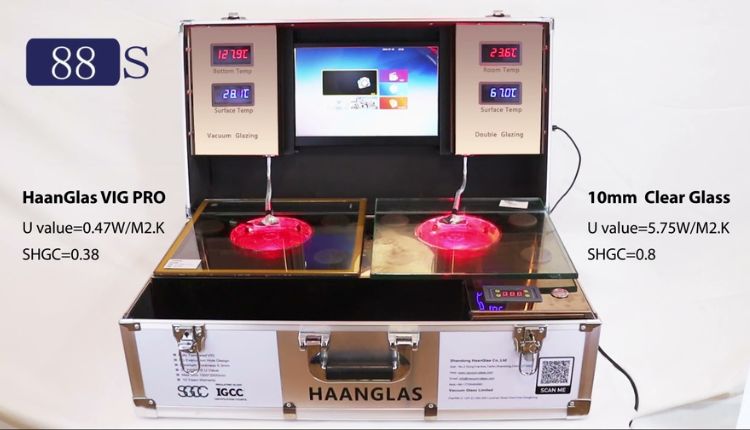Why VIG Outperforms Double & Triple Glazing in Canada, Scandinavia & Northern U.S. | HaanGlas

In ultra-cold climates—Canada, Scandinavia, Northern U.S.—the difference in window performance can make or break a building’s energy balance. While double and even triple glazing are common solutions, HaanGlas VIG (Vacuum Insulating Glass) brings a leapfrog advantage: better insulation, thinner profiles, and long-term stability under extreme conditions.
The Cold-Climate Challenge
In regions where outdoor winter temperatures drop to –30 °C or below, glazing must resist large temperature gradients without excessive thermal loss or condensation. Triple glazing often becomes bulky—up to 40+ mm thick—placing heavy loads on frames, and sometimes still failing to meet demanding U-value targets. Meanwhile, double glazing simply can’t keep up.
How VIG Wins: Structure + Physics
Vacuum Layer—No Gas, No Convection
Because HaanGlas VIG has an internal vacuum (≈10⁻⁴ Pa) between panes, there’s almost no gas conduction or convection—major paths for heat loss in double/triple glazing. This dramatically reduces thermal leakage.
Micro-Spacers with Minimal Conductance
Tiny support pillars maintain pane separation under atmospheric pressure, but due to their small cross-sectional area and optimized spacing, their thermal conduction is negligible compared to bulk glass.
Thin, Rigid Design
Where triple glazing demands thick glazing cavities and reinforced frames, VIG remains ~8 mm total thickness yet delivers thermal performance akin to triple glazing. That makes retrofitting easier and frame stresses lower.
Performance Data That Speaks Volumes
On the HaanGlas VIG Basic page, you’ll see U-values like 0.50 W/m²·K, a substantial improvement over many triple glazing options. The PRO series pushes that further to 0.47 W/m²·K, even in tempered, large-format units.
By contrast, standard triple glazing in cold climates often lies in the 0.60–0.80 W/m²·K range. That gap means VIG can reduce heat loss through windows by 20–40% compared to triple glazed units—depending on design, frame, and climate variables.
Why That Matters in Canada / Scandinavia / Northern U.S.
Huge Temperature Differentials
With indoor setpoints (20–22 °C) versus winter outdoors (–20 to –30 °C), the ΔT is extreme. Every increment of insulation counts heavily in energy bills.
Long Heating Seasons
These regions have heating demand many times longer than cooling. So the insulation gains from VIG compound over months rather than weeks.
VIG Condensation Resistance
VIG keeps interior glass surface temperatures higher, reducing condensation risk—crucial in extremely cold climates.
Slim Profiles for Historic or Aesthetic Projects
In Scandinavian and northern towns, respecting architectural heritage is common. VIG allows retrofits without changing window frames or depth.
Case Examples & Real-World Results
On HaanGlas’s Projects / Retrofitting with Energy-Efficient Vacuum Glazing page, several cold-climate projects showed energy savings up to 60% after VIG retrofits. In one PRO-level installation, the team highlighted excellent condensation resistance down to –60 °C conditions.
These successes show that VIG does more than compete—it dominates when climate is most punishing.
Practical Advantages for Architects & Builders
Less structural burden: lighter glazing = lighter frames or fewer reinforcements
Design flexibility: slim units integrate into narrow profiles and historic frames
One glazing system for many climates: no need for multiple product lines
Sustainability credentials: lower heating loads, reduced carbon emissions, better performance metrics
Check the Energy Efficiency policies and Green Building Certification Support pages to see how VIG contributes to LEED, Passive House, and net-zero goals.
Conclusion
In climates where winters bite and heating dominates energy budgets, HaanGlas VIG isn’t just better—it’s transformational. It outperforms double and triple glazing not by small margins, but decisively: thinner, lighter, higher insulating power, and more durable under extreme conditions.
Micro-Spacers with Minimal Conductance
Tiny support pillars maintain pane separation under atmospheric pressure, but due to their small cross-sectional area and optimized spacing, their thermal conduction is negligible compared to bulk glass.
Thin, Rigid Design
Where triple glazing demands thick glazing cavities and reinforced frames, VIG remains ~8 mm total thickness yet delivers thermal performance akin to triple glazing. That makes retrofitting easier and frame stresses lower.
Whether you’re in northern Canada, Scandinavia’s fjords, or the Upper Midwest U.S., VIG offers a glazing solution built for cold-climate performance. The future of high-performance windows in harsh climates is vacuum—and the future is now with HaanGlas.




